The Encyclopedia of Dead Rock Stars (256 page)
Read The Encyclopedia of Dead Rock Stars Online
Authors: Jeremy Simmonds

Despite many treasured memories, such as the Monterey Pop Festival of 1967, the musician revealed afterwards that his ‘experiences’ were not all happy ones while with Hendrix and John ‘Mitch’ Mitchell (drums). Creative in his own right, Redding found Hendrix to be fairly controlling, something he’d expected at first but of which he grew weary as time went by. After the release of the timeless
Electric Ladyland
(1968), he left the band; the main issue was that old chestnut: royalties. Although he was to remain friends with Hendrix until the latter’s untimely death
( September
September
1970), by 1974 Redding had been forced to sign away considerable future earnings from the three major hit albums (and several singles) issued by The Experience. (Financial problems in the eighties obliged the bassist to relinquish his prized Fender Jazz – the machine upon which he’d written many of his Experience bass lines – for £10K.) Redding’s own later bands, Fat Mattress – formed in 1969 with Neil Landon (vocals), Jim Leverton (guitar) and Eric Dillon (drums) – US rockers Road and finally The Noel Redding Band (an Irish-based act that also featured Thin Lizzy guitarist Eric Bell), were not commercially viable and the bassist’s financial situation became ever more precarious, prompting him to leave the UK.

Gerry Shepherd
(right)
with The Glitter Band: Showed much flare

Noel Redding
(left),
with Jimi Hendrix: A vital part of The Experience
‘Take away his role as the bass-player in the largest rock trio of all time and strip away all the glory of his musical career. As a human being, he was a fabulous guy.’
Ian Grant, Redding’s manager
Since the mid eighties, Redding had maintained a lower profile in his adopted Ireland, but visitors to the De Barra pub in County Cork would have heard the man play most Friday evenings. It was the owner of this establishment, Bobby Blackwell, who found Noel Redding’s body in the bathroom of his home in Ardfield, Clonakilty, on the evening of Monday 12 May 2003, the musician having failed to show for two nights. His death ascribed to ‘shock haemorrhage due to oesophageal varices in reaction to cirrhosis of the liver’, Redding was cremated a week later in west Dublin.
Monday 19
Camoflauge
(Jason Johnson - Savannah, Georgia, 9 December 1981)

As he walked to the building of his Savannah-based label, Pure Pain Records, accompanied by his young son (who thankfully remained unhurt), rapper Camoflauge became the latest to take the bullet as hip hop’s rollcall ticked off another name.
Already on his third album, Camoflauge was for some reason seen as a role model in his township, the only one of Savannah’s ‘sons’ to have achieved success in hip hop. Despite managing to pull himself some way out of the ghetto of his childhood to a Billboard-charting album,
I Represent
(2000), the rapper appeared to have few aspirations beyond the usual tiresome litany of guns, bling and ‘bitches’. He could also lay claim to that other ‘must-have’ of the self-respecting rap artist, a prison sentence. The year his first album was launched, Camoflauge spent two months inside under suspicion of murder, although he was released when a grand jury failed to indict him. The rapper really must have felt he’d hit the big time when Universal issued his second album – boasting the inspired title
Strictly 4 Da Streets: Sex, Drugs and Violence Vol 1
(2002) – but Camoflauge was dropped soon afterwards and signed to Pure Pain instead. Perhaps displaying how desperate Savannah was to promote one of its own, he was thereafter invited to speak at local schools and act as ‘Santa’ for the children of the housing project where he was brought up.
Despite being shot at the previous year, Camoflauge’s death in hospital was met with the usual mixture of shock and tributes to a martyr by his homeboys. Various suspects were interviewed, however several years later nobody had yet been charged with the rapper’s murder.
Sunday 25
Jeremy Michael Ward
(Fort Worth, Texas, 5 May 1976)
The Mars Volta
DeFacto

In 2003, The Mars Volta was one of the most interesting – and certainly most visually arresting – new bands to emerge from America. The group had risen from the ashes of strident SoCal políticos At the Drive-In, whose Cedric Bixler Zavala (vocals) and Omar Rodriguez-Lopez (guitar) had teamed up with Ikey Isaiah Owens (keyboards) and sound manipulator Jeremy Michael Ward, with whom both had worked in the band DeFacto. Ward was one of rock’s unsung heroes, an offstage performer and former repoman whose sonic inspirations guided much of each band’s output. In 2003, The Mars Volta promoted a full-length debut CD, the curiously titled
De-Loused in the Crematorium,
an album which (presciently) tells the story of a man in a drug-induced coma. To promote the record, they embarked upon a hectic schedule of dates with The Red Hot Chili Peppers across Europe where the band’s never-less-than-intriguing mix of psychedelics, pop and hardcore rock was particularly popular.
On their return from the other side of the world, The Mars Volta learned of the sudden death of Ward from a suspected heroin overdose. His body was found by his roommate in Los Angeles. Picking themselves up from the tragedy, the band recruited former ATDI member Paul Hinojos to replace the late soundsmith.
Friday 30
Mickie Most
(Michael Peter Hayes - Aldershot, Hampshire, 20 June 1938)
(The Playboys)

Mickie Most was one of the most prominent non-musician faces during the UK’s glamrock era – a clear-thinking, decisive presence amid a sea of glitter and decadence. While never possessing the maverick tendencies of a Joe Meek or Tony Visconti, Britain’s most prolific pop producer is still said to hold the record for the most number-one singles worldwide. If this comes as a surprise, then even more remarkable is the statistic of his own band, The Playboys, running off eleven straight number-one singles in South Africa with covers of US rock ‘n’ roll standards! Most, though, will chiefly be remembered for his engineering of so many stars’ careers. In the sixties he handled the records of Donovan, Herman’s Hermits, Brenda Lee and Lulu, beginning with the biggest hit of them all, The Animals’ ‘House of the Rising Sun’ (1964 – a track reportedly recorded in fifteen minutes for just £1 1s), which took his work to the top of the charts in twelve countries. Consolidating on this, Most then set up his own label, RAK (initially in conjunction with future Led Zeppelin manager Peter Grant), scoring further chartbusters with Hot Chocolate, Suzi Quatro and Smokie during a seemingly unstoppable period throughout the seventies. This unbroken triumph continued some way into the 1980s, Most discovering Kim Wilde when she was just a teenager, as well as collaborating with his son Calvin Hayes’s briefly successful band, Johnny Hates Jazz.

